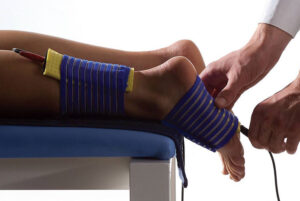Electrotherapy

Introduction to Electrotherapy
Electrotherapy is a therapeutic treatment that uses electrical stimulation to aid in pain relief, muscle rehabilitation, and overall recovery. This non-invasive technique has been widely adopted in physical therapy and sports medicine due to its effectiveness in treating various musculoskeletal conditions.
The Importance of Electrotherapy
Electrotherapy is crucial for enhancing the healing process, reducing pain, and improving muscle function. It provides a drug-free alternative for pain management, making it suitable for individuals seeking to avoid medication. Its versatility allows it to be used in conjunction with other therapies, creating a comprehensive treatment plan.
Types of Electrotherapy
• Transcutaneous Electrical Nerve Stimulation (TENS):
TENS uses low-voltage electrical currents to stimulate nerves and block pain signals to the brain. It’s commonly used for chronic pain conditions such as arthritis, back pain, and neuropathy.
• Neuromuscular Electrical Stimulation (NMES):
NMES involves sending electrical impulses to muscles, causing them to contract. This helps in strengthening weak muscles, improving muscle tone, and preventing muscle atrophy, especially after surgery or injury.
• Interferential Current (IFC) Therapy:
IFC therapy uses two high-frequency electrical currents that intersect below the skin’s surface. The interference of these currents provides deep tissue pain relief, reducing inflammation and promoting healing.
• Iontophoresis:
Iontophoresis uses electrical currents to deliver medication through the skin. It’s often used to treat localized inflammation and pain, such as tendinitis and bursitis, by directly targeting the affected area.
Benefits of Electrotherapy
• Pain Relief:
Electrotherapy effectively reduces acute and chronic pain by interrupting pain signals and stimulating the release of endorphins, the body’s natural painkillers. It provides immediate relief and can be used alongside other pain management strategies.
• Muscle Rehabilitation:
By stimulating muscle contractions, electrotherapy helps in rebuilding strength and improving muscle function. It is particularly beneficial for patients recovering from surgery, injury, or neurological conditions.
• Enhanced Circulation:
Electrical stimulation promotes blood flow to the treated area, aiding in the delivery of oxygen and nutrients necessary for tissue repair and recovery. Improved circulation also helps in reducing swelling and inflammation.
• Non-Invasive and Drug-Free:
Electrotherapy is a non-invasive treatment that doesn’t require medication, making it an attractive option for individuals seeking alternative pain relief methods. It has minimal side effects and can be safely used for extended periods.
Applications of Electrotherapy
• Physical Therapy:
In physical therapy, electrotherapy is used to enhance recovery from injuries, surgeries, and musculoskeletal conditions. It helps in pain management, muscle strengthening, and improving joint mobility.
• Sports Medicine:
Athletes use electrotherapy to manage pain, reduce inflammation, and accelerate recovery from sports-related injuries. It’s a key component in injury prevention and performance enhancement programs.
• Chronic Pain Management:
For individuals with chronic pain conditions such as fibromyalgia, arthritis, and neuropathy, electrotherapy provides a non-invasive option for ongoing pain relief and improved quality of life.
• Post-Surgical Recovery:
Electrotherapy aids in post-surgical rehabilitation by reducing pain, preventing muscle atrophy, and promoting tissue healing. It supports faster recovery and helps patients regain functional abilities more quickly.
